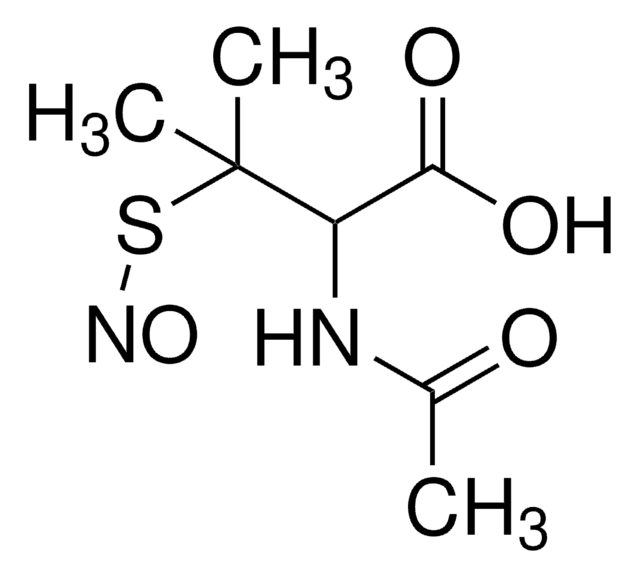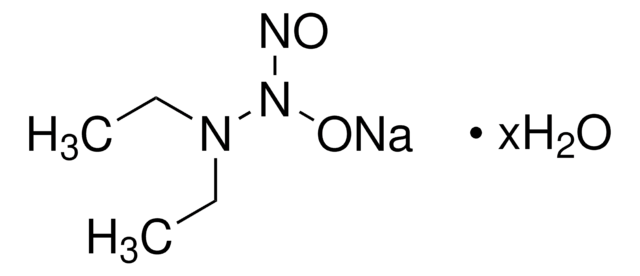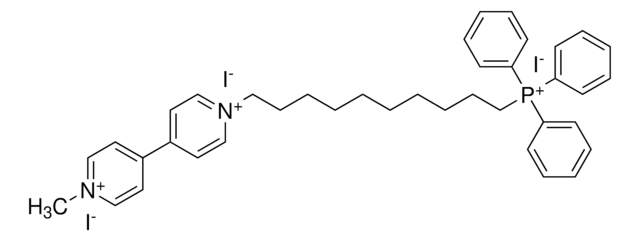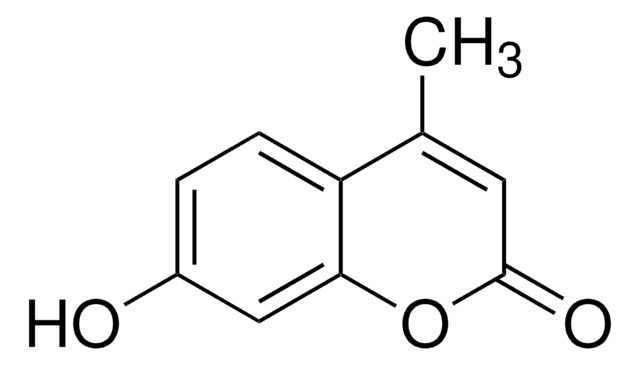E3145
3-Ethyl-3-(ethylaminoethyl)-1-hydroxy-2-oxo-1-triazene
≥90%
Sinónimos:
NOC-12
Iniciar sesiónpara Ver la Fijación de precios por contrato y de la organización
About This Item
Fórmula empírica (notación de Hill):
C6H16N4O2
Número de CAS:
Peso molecular:
176.22
MDL number:
UNSPSC Code:
12352200
PubChem Substance ID:
NACRES:
NA.77
Productos recomendados
Quality Level
assay
≥90%
storage temp.
−20°C
SMILES string
CCNCCN(CC)\[N+]([O-])=N\O
InChI
1S/C6H16N4O2/c1-3-7-5-6-9(4-2)10(12)8-11/h7,11H,3-6H2,1-2H3/b10-8-
InChI key
DPKCLDSTXVCYSN-NTMALXAHSA-N
General description
3-Ethyl-3-(ethylaminoethyl)-1-hydroxy-2-oxo-1-triazene (NOC12) is a donor of nitric oxide (NO). It has a long half-life of 327 minutes.
Application
3-Ethyl-3-(ethylaminoethyl)-1-hydroxy-2-oxo-1-triazene has been used as nitric oxide (NO) donor to study its effects on the isolated trachea preparations from control and ovalbumin-sensitized guinea pigs in vitro. It has also been used as a NO-releasing substance to study its effects on the body contractions patterns of Tethya wilhelma.
Biochem/physiol Actions
3-Ethyl-3-(ethylaminoethyl)-1-hydroxy-2-oxo-1-triazene (NOC12) liberates nitric oxide (NO) without the use of cofactors or enzymes and the formation of hazardous metabolites. A low dose of NOC12 protects astrocytes from reperfusion injury via a cyclic guanosine monophosphate (cGMP) signal. Higher dosages of NOC12 aggravates reperfusion damage through a cyclic guanosine monophosphate (cGMP)-independent mechanism.
signalword
Danger
hcodes
Hazard Classifications
Self-react. C
Storage Class
5.2 - Organic peroxides and self-reacting hazardous materials
wgk_germany
WGK 3
flash_point_f
Not applicable
flash_point_c
Not applicable
ppe
dust mask type N95 (US), Eyeshields, Gloves
Elija entre una de las versiones más recientes:
¿Ya tiene este producto?
Encuentre la documentación para los productos que ha comprado recientemente en la Biblioteca de documentos.
Ahmet Parlak et al.
Experimental lung research, 38(8), 420-426 (2012-10-04)
Asthma is a chronic inflammatory disease in which cell components play important roles. We aimed to evaluate the effects of NO/cGMP cleavage at trachea preparations isolated from ovalbumin-sensitized guinea pigs in vitro. Trachea rings were exposed to 3-ethyl-3-(ethylaminoethyl)-1-hydroxy-2-oxo-1-triazene (NOC-12), (±)-(E)-4-ethyl-2-[(Z)-hydroxyimino]-5-nitro-3-hexen-1-yl-nicotinamide
Kornelia Ellwanger et al.
Frontiers in zoology, 3, 7-7 (2006-04-29)
Sponges (Porifera) are nerve- and muscleless metazoa, but display coordinated motor reactions. Therefore, they represent a valuable phylum to investigate coordination systems, which evolved in a hypothetical Urmetazoon prior to the central nervous system (CNS) of later metazoa. We have
Kazuhiro Takuma et al.
Japanese journal of pharmacology, 89(1), 64-71 (2002-06-27)
We examined the effect of 3-ethyl-3-(ethylaminoethyl)-1-hydroxy-2-oxo-1-triazene (NOC12), a nitric oxide (NO) donor, on apoptosis in cultured astrocytes. Reperfusion after hydrogen peroxide (H2O2) exposure caused a decrease in cell viability, loss of mitochondrial membrane potential, caspase-3 activation, DNA ladder formation, and
Cristiane Salum et al.
Neurotoxicity research, 29(1), 92-104 (2015-09-24)
Previous research has shown that nitric oxide (NO) synthase inhibitors prevent rodents' sensorimotor gating impairments induced by dopamine releasing drugs, such as amphetamine (Amph) and methylphenidate. The mechanisms of this effect have not been entirely understood. In the present work
Tengfang Ling et al.
The Plant cell, 29(11), 2871-2881 (2017-11-01)
Pathogens deliver effectors into plant cells to suppress immunity-related signaling. However, effector recognition by the host elicits a hypersensitive response (HR) that overcomes the inhibition of host signaling networks, restoring disease resistance. Signaling components are shared between the pathogen-associated molecular
Nuestro equipo de científicos tiene experiencia en todas las áreas de investigación: Ciencias de la vida, Ciencia de los materiales, Síntesis química, Cromatografía, Analítica y muchas otras.
Póngase en contacto con el Servicio técnico









